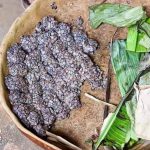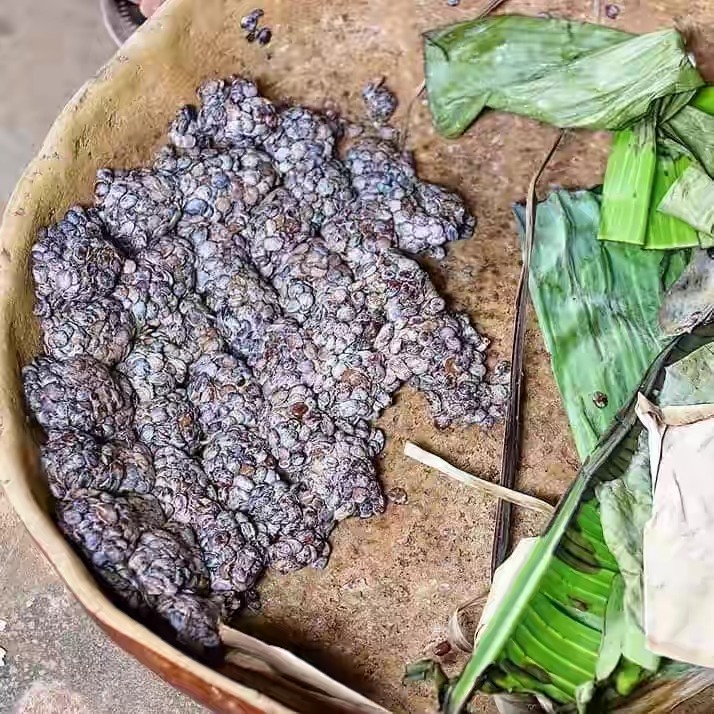Amazing health benefits of African locust beans (Ɗorowa’ or ‘dawadawa’ in Hausa), ‘Iru’ in Yoruba, ‘ogiri’ in Igbo, ‘eware’ in edo, Parkia in Latin.
Locust bean (Parkia biglobosa) is an economic tree. There are two species of Parkia in Nigeria. These are Parkia biocolor and Parkia biglobosa. This tree is protected by the peasant farmers and rural dwellers for its many benefits. Daddawa (Dawadawa) is the Hausa name for fermented African locust bean condiment in the savanna region of West and Central Africa.
This bouillon cubes constitutes a significant part of the diet of many West Africans. It is used for flavouring described as a miracle crop and a good source of protein.
It could help to satisfy the protein deficiency currently experienced in some developing countries, including Nigeria.

Daddawa is also a good source of beneficial bacteria called probiotics. This is important since many Africans do not consume yoghurt or fermented dairy products that contain these good bacteria. This beyond the reach of low socio-economic groups.
However in the savannah zone where Parkia is abundant, there has been a shift in the intensity of food production. There is an extensive clearing of land for arable farming, which leads to the elimination of some of the locust bean trees.
What a pity! Rural dwellers in developing countries like Nigeria cannot afford animal products which are rich sources of protein because they are either too expensive or simply unavailable.
Staple diets consist mainly of cereal grains or starchy roots and tuber crops thus leading to various health problems associated with protein and vitamin / mineral deficiencies.
In the search for plant protein and vitamin substitutes, the African locust bean (Parkia biglobosa) has found very popular use especially in the fermented ‘daddawa or dawadawa’ (Hausa) or Iru (Yoruba) form, which is a product of the seeds.
However, the yellow dry powdery fruit pulp called ‘Ɗorowa’ in Hausa has not attracted much attention. Some scientist working with the United States Department of Agriculture Nutrient Database have reported the nutritional value of the African locust bean seeds with a proximate composition of 30.00% protein, 15.00% fat, 4.00% crude fibre, 2.00% ash and 49.00% carbohydrate.
The powdery fruit pulp from which Ɗorowa drink is made contains more carbohydrate than the seeds, the carbohydrates being primarily reducing sugars (19.00%), non-reducing sugars (9.00%) and other complex carbohydrates (36.00%).
The fruit pulp of the African locust bean is sweet to the taste, which indicates the presence of natural sugars and thus a potential energy source.
The attractive yellow colour indicates the presence of phytochemicals, possibly carotenoids, which are important precursors of retinol (vitamin A).
It has a sour taste which indicates the presence of ascorbic acid (vitamin C). Literature reveals that the fruit pulp is used in rural Africa during emergencies, when the grain stores are depleted or empty, which is an indication of its edibility and non-toxicity.
It may also be used as an ingredient in the preparation of various stews, soups and sauces for the consumption of cereals; pressed into cakes and preserved for later use or used in the preparation of some indigenous drinks.
Ɗorowa drink is more than adequate to meet the FAO/WHO recommended daily allowance of protein of about 0.60 g/kg body weight for an average healthy individual and 0.88 g/kg body weight for children aged 1 to 10 years. Carbohydrate content of Ɗorowa has been found to be 67.30%.
This is much higher than the seeds (49.49). It is also higher than most legume seeds with only lentils and bambara ground nuts coming close with a value of 65.0%.
Though proteins and fats also provide energy, carbohydrates are much cheaper and more easily digested and absorbed.
With this content of carbohydrate the African locust bean fruit pulp is a potential good source of energy taking into consideration the present recommended daily energy intake.
The crude fiber was found to be 11.75%, which is higher than most of the foods we eat. Though crude fiber does not contribute nutrients or energy, it is a source of dietary fiber which is essential for good bowel movement and helps in preventing obesity, diabetes, cancer of the colon and other disorders of the gastrointestinal tract of humans.
Though the crude fibre obtained for the fruit pulp is less than that of the seeds (18.00%) as reported by some scientist, it is much higher than for most food legumes, which range from 2.10% in ground nuts to 7.60% in kidney beans.
This makes the African locust beans fruit pulp a potential good source of dietary fibre. Crude fat was found to be 18%.
This is in conformity with most legumes, which apart from ground nuts (45.30%), soya beans (17.70%) and winged bean (17.00%), all have less than 30% fat. The ash (mineral) content of 4.18% is within the range for most legumes of 2.00% in peas to 5.00% in soya beans.
This is much higher than the 1.00% obtained for the fruit pulp of the Mediterranean species and is an indication that the African locust bean fruit pulp is a potential good source of minerals required by the body.
Total carotenoids amounted to 49,175 IU/100g. This value is much higher than that obtained for some commonly consumed foods like yellow maize, plantain, cabbage, mango and carrots.
Some carotenoids are usually converted to retinol (Vitamin A) in the human body, and its colour also makes food more attractive to the eye.
This value of carotenoids indicates that the fruit pulp is a potential source of vitamin A given that the recommended daily intake is about 1000 mcg per adult humans.
Vitamin C (ascorbic acid) content was found to be 191.20 mcg/100g, which is quite high for locust bean yellow pulp. This is higher than most regularly consumed foodstuff and adequate compared to the recommended daily intake of about 90 mg adult humans.
Vitamin C is very useful in collagen synthesis, facilitates iron absorption and participates in the production of the hormones glucocorticoids.
This article on African locust beans are the thoughts of:
Sa’eed Halilu Bawa
Senior Lecturer (Associate Professor) at University of the West Indies, St. Augustine Campus, Trinidad.
Studied Food and Nutrition Sciences, Dietetics at Kaduna Polytechnic, Nigeria; Warsaw University of Life Sciences, Poland.
























